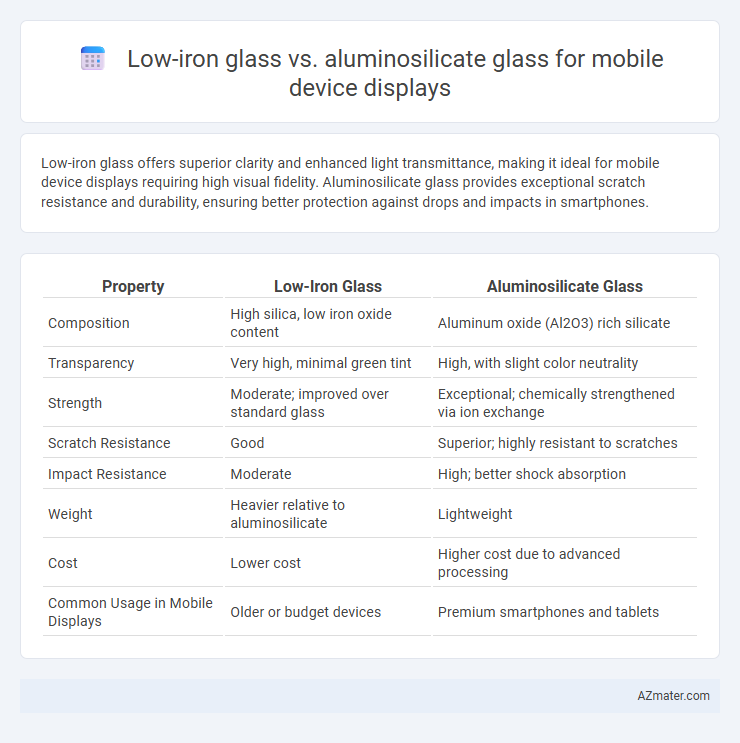Low-iron glass offers superior clarity and enhanced light transmittance, making it ideal for mobile device displays requiring high visual fidelity. Aluminosilicate glass provides exceptional scratch resistance and durability, ensuring better protection against drops and impacts in smartphones.
Table of Comparison
| Property | Low-Iron Glass | Aluminosilicate Glass |
|---|---|---|
| Composition | High silica, low iron oxide content | Aluminum oxide (Al2O3) rich silicate |
| Transparency | Very high, minimal green tint | High, with slight color neutrality |
| Strength | Moderate; improved over standard glass | Exceptional; chemically strengthened via ion exchange |
| Scratch Resistance | Good | Superior; highly resistant to scratches |
| Impact Resistance | Moderate | High; better shock absorption |
| Weight | Heavier relative to aluminosilicate | Lightweight |
| Cost | Lower cost | Higher cost due to advanced processing |
| Common Usage in Mobile Displays | Older or budget devices | Premium smartphones and tablets |
Introduction to Mobile Device Display Glass
Low-iron glass offers enhanced clarity and brightness due to its reduced iron content, making it ideal for mobile device displays requiring vibrant visuals. Aluminosilicate glass provides superior durability and scratch resistance, enhancing device longevity and user experience. Both materials are crucial in balancing display quality and protection, influencing overall device performance and consumer satisfaction.
Composition of Low-Iron Glass
Low-iron glass for mobile device displays contains reduced iron oxide content, typically less than 0.01%, which enhances light transmission and color clarity compared to standard soda-lime glass. This composition minimizes greenish tint, boosting screen brightness and visual accuracy crucial for high-resolution displays. In contrast, aluminosilicate glass incorporates alumina and silica to provide superior hardness and scratch resistance but does not primarily focus on refractive purity or reduced iron content.
Composition of Aluminosilicate Glass
Aluminosilicate glass used in mobile device displays consists primarily of silica (SiO2), alumina (Al2O3), and alkali metal oxides, providing enhanced mechanical strength and scratch resistance compared to low-iron glass. The inclusion of alumina increases the glass's chemical durability and thermal stability, making it more resistant to damage from drops and temperature fluctuations. This composition allows aluminosilicate glass to deliver superior performance in smartphones and tablets requiring durable, clear, and lightweight display materials.
Optical Clarity: Low-Iron vs Aluminosilicate
Low-iron glass offers superior optical clarity with higher light transmittance and reduced greenish tint, making it ideal for mobile device displays requiring vibrant color accuracy and brightness. Aluminosilicate glass, while exceptionally strong and scratch-resistant, tends to have slightly lower light transmission and minor color distortion due to its composition. Choosing low-iron glass enhances visual sharpness and true-to-life color representation on screens, whereas aluminosilicate prioritizes durability with a modest trade-off in optical performance.
Strength and Durability Comparison
Low-iron glass offers enhanced clarity and vibrant color reproduction but has lower strength and scratch resistance compared to aluminosilicate glass, which is chemically strengthened through an ion-exchange process. Aluminosilicate glass, commonly used in mobile device displays like Gorilla Glass, provides superior impact resistance and durability against drops and scratches. Its higher elasticity and fracture toughness make it the preferred choice for rugged mobile devices requiring prolonged durability and protection.
Scratch and Crack Resistance
Low-iron glass typically offers enhanced clarity but has lower scratch and crack resistance compared to aluminosilicate glass, which is chemically strengthened through ion exchange to improve durability. Aluminosilicate glass, commonly used in mobile device displays like Gorilla Glass, provides superior protection against scratches and cracks due to its increased surface compressive stress and toughness. For applications prioritizing screen longevity and impact resistance, aluminosilicate glass is the preferred material choice over low-iron glass.
Touch Sensitivity and User Experience
Low-iron glass offers enhanced clarity and vibrant color accuracy for mobile device displays, improving visual touch sensitivity by allowing more precise interaction with the screen. Aluminosilicate glass, known for its superior hardness and resistance to scratches, maintains consistent touch responsiveness over time, which enhances long-term user experience and device durability. Choosing between the two impacts both immediate touch accuracy and the display's ability to withstand wear, critical factors in overall touchscreen performance and satisfaction.
Manufacturing Costs and Scalability
Low-iron glass offers lower raw material costs and simpler manufacturing processes compared to aluminosilicate glass, making it more cost-effective for large-scale production. Aluminosilicate glass requires specialized high-temperature processing and ion-exchange strengthening, which increases manufacturing complexity and expenses. While low-iron glass scales efficiently for mass production, aluminosilicate glass's performance benefits justify higher costs in premium mobile device displays.
Environmental Impact and Sustainability
Low-iron glass offers higher light transmittance and clarity, reducing energy consumption in devices with brighter, more efficient displays, thus lowering the environmental footprint during use. Aluminosilicate glass, known for superior durability and scratch resistance, extends the lifespan of mobile devices, decreasing e-waste and resource demand for replacements. Manufacturing aluminosilicate glass generally requires more energy and complex processes than low-iron glass, making the latter more favorable in terms of lower production emissions and sustainable resource utilization.
Future Trends in Display Glass Technologies
Low-iron glass offers enhanced clarity and color accuracy, making it a preferred choice for high-resolution mobile displays, while aluminosilicate glass excels in durability and scratch resistance, crucial for rugged device designs. Future trends indicate a shift towards hybrid glass composites integrating low-iron and aluminosilicate properties for optimized performance in flexible and foldable screens. Advances in thin-film coatings and nanotechnology will further enhance the strength, clarity, and touch sensitivity of display glass, driving innovation in next-generation mobile devices.

Infographic: Low-iron glass vs Aluminosilicate glass for Mobile device display
 azmater.com
azmater.com